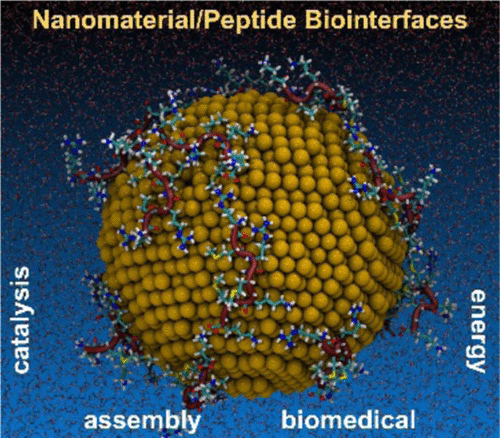当前位置:
X-MOL 学术
›
Chem. Rev.
›
论文详情
Our official English website, www.x-mol.net, welcomes your feedback! (Note: you will need to create a separate account there.)
Biointerface Structural Effects on the Properties and Applications of Bioinspired Peptide-Based Nanomaterials
Chemical Reviews ( IF 62.1 ) Pub Date : 2017-08-29 00:00:00 , DOI: 10.1021/acs.chemrev.7b00139 Tiffany R. Walsh 1 , Marc R. Knecht 2
Chemical Reviews ( IF 62.1 ) Pub Date : 2017-08-29 00:00:00 , DOI: 10.1021/acs.chemrev.7b00139 Tiffany R. Walsh 1 , Marc R. Knecht 2
Affiliation

|
Peptide sequences are known to recognize and bind different nanomaterial surfaces, which has resulted in the screening and identification of hundreds of peptides with the ability to bind to a wide range of metallic, metal oxide, mineral, and polymer substrates. These biomolecules are able to bind to materials with relatively high affinity, resulting in the generation of a complex biointerface between the biotic and abiotic components. While the number of material-binding sequences is large, at present, quantitative materials-binding characterization of these peptides has been accomplished only for a relatively small number of sequences. Moreover, it is currently very challenging to determine the molecular-level structure(s) of these peptides in the materials adsorbed state. Despite this lack of data related to the structure and function of this remarkable biointerface, several of these peptide sequences have found extensive use in creating functional nanostructured materials for assembly, catalysis, energy, and medicine, all of which are dependent on the structure of the individual peptides and collective biointerface at the material surface. In this Review, we provide a comprehensive overview of these applications and illustrate how the versatility of this peptide-mediated approach for the growth, organization, and activation of nanomaterials could be more widely expanded via the elucidation of biointerfacial structure/property relationships. Future directions and grand challenges to realize these goals are highlighted for both experimental characterization and molecular-simulation strategies.
中文翻译:

生物界面结构对基于生物启发的肽基纳米材料的性能和应用的影响
已知肽序列识别并结合不同的纳米材料表面,从而筛选和鉴定了数百种具有与多种金属,金属氧化物,矿物和聚合物底物结合能力的肽。这些生物分子能够以相对较高的亲和力与材料结合,从而在生物和非生物成分之间产生复杂的生物界面。尽管物质结合序列的数目很大,但是目前,仅对于相对少量的序列就已经完成了这些肽的定量物质结合表征。而且,目前在材料吸附状态下确定这些肽的分子水平结构是非常具有挑战性的。尽管缺乏与这种出色的生物界面的结构和功能相关的数据,但这些肽序列中的一些已广泛用于创建用于组装,催化,能量和药物的功能性纳米结构材料,所有这些都取决于蛋白质的结构。单个肽和材料表面的集体生物界面。在这篇综述中,我们提供了对这些应用的全面概述,并说明了如何通过阐明生物界面结构/性质之间的关系,更广泛地扩展这种肽介导的方法对纳米材料的生长,组织和激活的多功能性。实验表征和分子模拟策略都强调了实现这些目标的未来方向和重大挑战。这些肽序列中的几个已广泛用于创建用于组装,催化,能源和医学的功能性纳米结构材料,所有这些都取决于单个肽的结构和材料表面的集体生物界面。在这篇综述中,我们提供了对这些应用的全面概述,并说明了如何通过阐明生物界面结构/性质之间的关系,更广泛地扩展这种肽介导的方法对纳米材料的生长,组织和激活的多功能性。实验表征和分子模拟策略都强调了实现这些目标的未来方向和重大挑战。这些肽序列中的几个已广泛用于创建用于组装,催化,能源和医学的功能性纳米结构材料,所有这些都取决于单个肽的结构和材料表面的集体生物界面。在本综述中,我们提供了对这些应用的全面概述,并说明了如何通过阐明生物界面结构/性质关系来更广泛地扩展这种肽介导的方法对纳米材料的生长,组织和激活的多功能性。实验表征和分子模拟策略都强调了实现这些目标的未来方向和重大挑战。催化,能量和药物,所有这些都取决于单个肽的结构和材料表面的集体生物界面。在本综述中,我们提供了对这些应用的全面概述,并说明了如何通过阐明生物界面结构/性质关系来更广泛地扩展这种肽介导的方法对纳米材料的生长,组织和激活的多功能性。实验表征和分子模拟策略都强调了实现这些目标的未来方向和重大挑战。催化,能量和药物,所有这些都取决于单个肽的结构和材料表面的集体生物界面。在这篇综述中,我们提供了对这些应用的全面概述,并说明了如何通过阐明生物界面结构/性质之间的关系,更广泛地扩展这种肽介导的方法对纳米材料的生长,组织和激活的多功能性。实验表征和分子模拟策略都强调了实现这些目标的未来方向和重大挑战。我们提供了这些应用程序的全面概述,并说明了如何通过阐明生物界面结构/属性关系来更广泛地扩展这种肽介导的方法用于纳米材料的生长,组织和激活的多功能性。实验表征和分子模拟策略都强调了实现这些目标的未来方向和重大挑战。我们提供了这些应用程序的全面概述,并说明了如何通过阐明生物界面结构/属性关系来更广泛地扩展这种肽介导的方法用于纳米材料的生长,组织和激活的多功能性。实验表征和分子模拟策略都强调了实现这些目标的未来方向和重大挑战。
更新日期:2017-08-29
中文翻译:

生物界面结构对基于生物启发的肽基纳米材料的性能和应用的影响
已知肽序列识别并结合不同的纳米材料表面,从而筛选和鉴定了数百种具有与多种金属,金属氧化物,矿物和聚合物底物结合能力的肽。这些生物分子能够以相对较高的亲和力与材料结合,从而在生物和非生物成分之间产生复杂的生物界面。尽管物质结合序列的数目很大,但是目前,仅对于相对少量的序列就已经完成了这些肽的定量物质结合表征。而且,目前在材料吸附状态下确定这些肽的分子水平结构是非常具有挑战性的。尽管缺乏与这种出色的生物界面的结构和功能相关的数据,但这些肽序列中的一些已广泛用于创建用于组装,催化,能量和药物的功能性纳米结构材料,所有这些都取决于蛋白质的结构。单个肽和材料表面的集体生物界面。在这篇综述中,我们提供了对这些应用的全面概述,并说明了如何通过阐明生物界面结构/性质之间的关系,更广泛地扩展这种肽介导的方法对纳米材料的生长,组织和激活的多功能性。实验表征和分子模拟策略都强调了实现这些目标的未来方向和重大挑战。这些肽序列中的几个已广泛用于创建用于组装,催化,能源和医学的功能性纳米结构材料,所有这些都取决于单个肽的结构和材料表面的集体生物界面。在这篇综述中,我们提供了对这些应用的全面概述,并说明了如何通过阐明生物界面结构/性质之间的关系,更广泛地扩展这种肽介导的方法对纳米材料的生长,组织和激活的多功能性。实验表征和分子模拟策略都强调了实现这些目标的未来方向和重大挑战。这些肽序列中的几个已广泛用于创建用于组装,催化,能源和医学的功能性纳米结构材料,所有这些都取决于单个肽的结构和材料表面的集体生物界面。在本综述中,我们提供了对这些应用的全面概述,并说明了如何通过阐明生物界面结构/性质关系来更广泛地扩展这种肽介导的方法对纳米材料的生长,组织和激活的多功能性。实验表征和分子模拟策略都强调了实现这些目标的未来方向和重大挑战。催化,能量和药物,所有这些都取决于单个肽的结构和材料表面的集体生物界面。在本综述中,我们提供了对这些应用的全面概述,并说明了如何通过阐明生物界面结构/性质关系来更广泛地扩展这种肽介导的方法对纳米材料的生长,组织和激活的多功能性。实验表征和分子模拟策略都强调了实现这些目标的未来方向和重大挑战。催化,能量和药物,所有这些都取决于单个肽的结构和材料表面的集体生物界面。在这篇综述中,我们提供了对这些应用的全面概述,并说明了如何通过阐明生物界面结构/性质之间的关系,更广泛地扩展这种肽介导的方法对纳米材料的生长,组织和激活的多功能性。实验表征和分子模拟策略都强调了实现这些目标的未来方向和重大挑战。我们提供了这些应用程序的全面概述,并说明了如何通过阐明生物界面结构/属性关系来更广泛地扩展这种肽介导的方法用于纳米材料的生长,组织和激活的多功能性。实验表征和分子模拟策略都强调了实现这些目标的未来方向和重大挑战。我们提供了这些应用程序的全面概述,并说明了如何通过阐明生物界面结构/属性关系来更广泛地扩展这种肽介导的方法用于纳米材料的生长,组织和激活的多功能性。实验表征和分子模拟策略都强调了实现这些目标的未来方向和重大挑战。


























 京公网安备 11010802027423号
京公网安备 11010802027423号